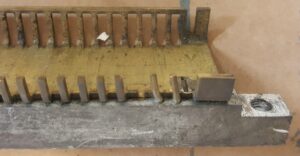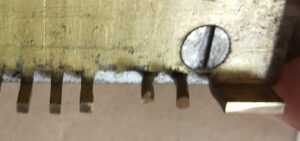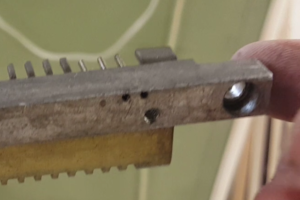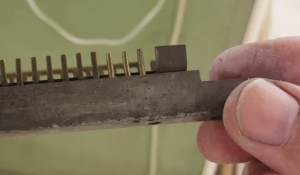This is yet another repair I had to make on the Linotype at the MacKenzie Printery and Newspaper Museum.
The keyboard assembly has a row of 91 short pushrods, known as the Lower Reeds, which push up when a key is pressed, ultimately releasing a matrix from the magazine above. The magazine has 90 channels but there is also a lower reed for releasing spacebands.
These reeds are supported and aligned by a double comb made of brass (part number H-2484). The lower part of the comb has closed slots for the reeds to pass through, but the upper part of the comb is just open teeth to space the reeds apart. These teeth are vulnerable to damage if the keyboard is swung out on its pivot (e.g. for maintenance) when some of the reeds are raised (e.g. due to keyboard jams), unless the operator takes precautions to prevent the raised reeds from striking the lower ends of adjacent upper reeds.
The comb is mounted on a steel support bar (H-2485) by several screws (H-207), and the entire assembly has part number H-2580.
The keyboard at the museum has had three of these comb teeth broken off; two had been repaired in the past, and now I have repaired the third one in the same manner.
The comb is formed from sheet brass, and it would be pretty much impossible to weld/braze/solder on a replacement tooth. However, the repair used on the other two teeth is fairly easy to repeat. A 1/16″ hole is drilled in the steel support bar exactly where the comb tooth should be, and a short piece of 1/16″ brass rod (I used brazing rod) is inserted. In my case the rod was a good enough fit in the hole to stay put, but if necessary a locking compound (such as Loctite™ 638) could be used to retain the rod.
The hole was not as accurately positioned as I would have liked, especially where it broke through the rear of the steel bar, but the tolerances in this particular area of the Linotype could be described as “sloppy” so it was easy to bend the rod to line it up good enough. The two teeth from a previous repair, as well as a couple of intact teeth on the comb, were also gently bent back into alignment.
Reinstalling this comb was a bit of a juggling act because of the need to keep 91 lower reeds from going astray. I think it was easier to install this bar and comb, and remove the other bar (which has a vertical stop for the reed motion) instead. I could then drop all the lower reeds into the comb, using a steel ruler to prevent them from falling out or dropping too low (the reeds have a notch in their side which limits their vertical movement). I could then use the ruler to raise all the reeds a bit so the bar could be reinstalled. I suspect an alternative might be to trip all the keyboard cams so they would hold the reeds up in such a way that the bar could be reinstalled.





this is exactly my problem
thanks for this idea i will try your solution – don’t know why i did not think of that myself